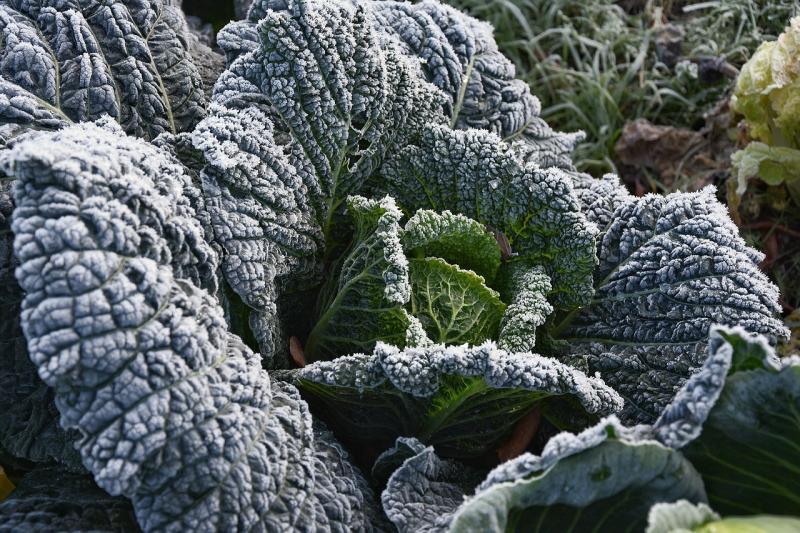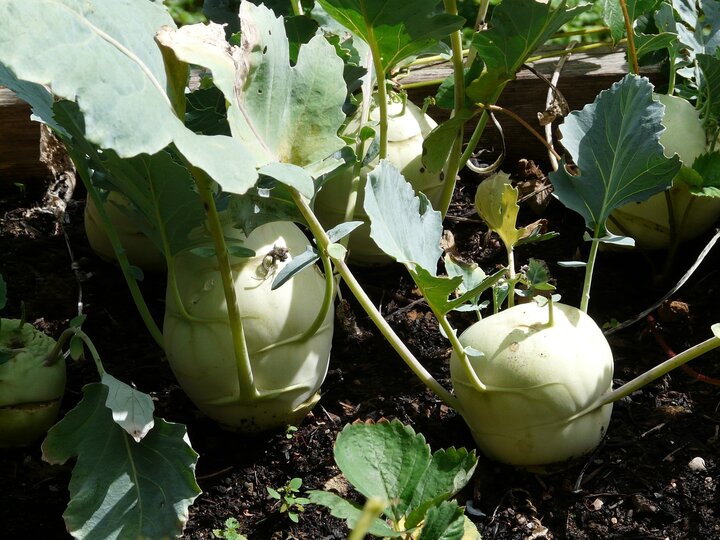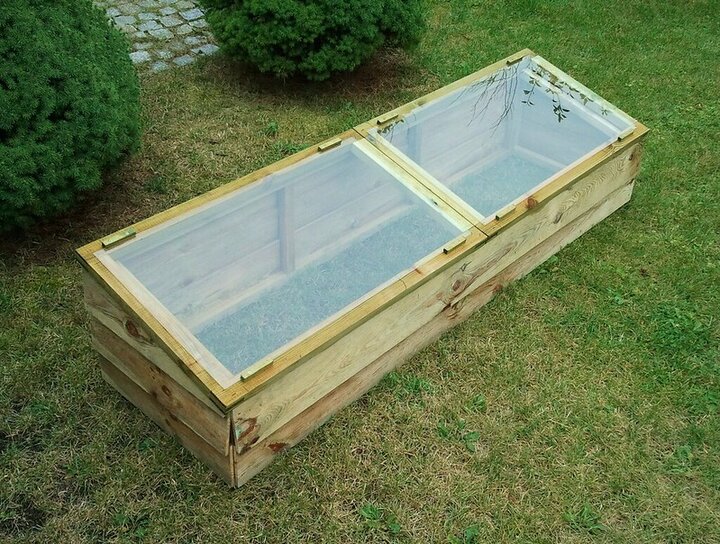Sarah Browning, Nebraska Extension Educator

Fall planting can extend the vegetable garden season into fall and winter. Image of frost on a cabbage, from Pixabay.com.
Many gardeners think vegetables can only be planted in spring, but they can also be planted in fall with either of two goals in mind:
- harvest in fall or winter, or
- harvest in spring from cold-hardy plants that have overwintered.
No matter which harvesting plan you’re shooting for, planting usually starts in July and continues through August. Most cool-season vegetables grow as well as, or better, than those planted in spring as they mature during cooler weather. Flavor is also better on vegetables maturing during autumn or winter, often sweeter and milder.
What to Plant?

Semi-hardy vegetables can stand light frost, 30-32° F. This includes beets, Chinese cabbage, collards, green onions, mustard greens, potatoes, radishes, spinach, Swiss chard and lettuce (bibb and leaf).
Hardy vegetables can stand several frosts, but are killed when temperatures drop near 20°F unless provided protection by a high tunnel, low tunnel, greenhouse, coldframe or other protection method. This includes broccoli, Brussels sprouts, cabbage, carrots, cauliflower, kale, kohlrabi, rutabagas, turnips.
When to Plant?
To decide when to plant, get out your calendar and start counting backward from the normal first frost date for your area - for Lincoln and Lancaster county, that date is October 1-10. Find the date for your location. However, we often have a few weeks of continued good growing weather after the first frost, so if you’re willing to provide frost protection you can extend the growing season further.
Add together the days-to-harvest listed on the seed packet and the number of days you'll need to harvest a crop. If the crop is sensitive to cold, add in 10-14 days as a cushion to avoid damage from an early frost.
The growth rate of cold sensitive plants slows as temperatures get cool and all plants respond to the shorter fall day length by slowing their growth. Add in another 10-14 days to account for this “fall factor”.
Add these together for the total number of days, to grow and harvest each crop. Counting backward from the first frost date will give a good estimate of when to seed.
Persephone Period

When daylight falls below 10 hours per day, plant growth largely ceases. In planning for a late fall harvest, calculate seeding times so plants will be mature and ready to harvest before the Persephone period starts in your location. When planning for a late winter/spring harvest, calculate planting dates so the crops will have reached maturity or near maturity by the Persephone period. Mature crops will stay dormant in the cold ground, not growing any further, and can be harvest throughout winter. Near mature crops will also stay dormant, but be ready to spring into the final stages of grow when longer days return in February/March.
Another strategy is to start transplants of cool-season crops indoors and plant them into a protected structure just after the Persephone period ends in spring, giving yourself a head start on an early spring harvest.
This period is calculated by your location - latitude and longitude. In Lincoln, the Persephone period is from November 11thto January 31st. Check out this day length calculator to determine the Persephone period in your area.
Site Preparation
Fall vegetables do much better on soils that have been prepared and allowed to settle for one or two weeks. Areas used for spring crops can be reused for the fall garden but be sure to rotate crops; for example, don’t plant fall cabbage where you had spring cabbage. Plant something from a different vegetable family in the spring cabbage area.
Since we are still having some warm daytime temperatures, follow these suggestions to get your fall crops going
- Remove all the old vegetation left by the spring crop. Put it in the compost pile or dig a hole and pit compost it.
- Prepare a shallow, firm seed bed. Avoid deep plowing at this time.
- Soak the seeds overnight before planting.
- Plant seeds slightly deeper than recommended for spring gardens.
- After plants are well established, thin them to the proper spacing and apply mulch.
Images:
- Kohlrabi is a hardy cold-season crop that can withstand several freezes in fall or be stored in the ground throughout winter under a heavy mulch. Image by Pixabay.
- A coldframe can be used to extend the vegetable gardening season in fall, winter and early spring. Image - Large Cold Frame, by best4garden-wood products. CC BY-SA 2.0.
Search Our Archive
Associated Video
Planting a Fall Garden
Nebraska Extension Educator Elizabeth Exstrom gives some tips to starting a fall garden.